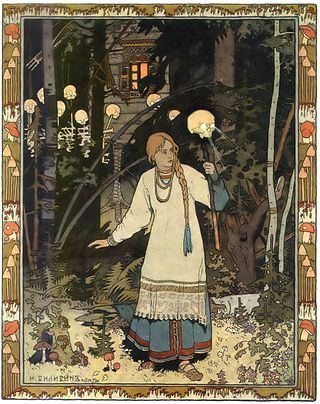The Aarne–Thompson–Uther Index is a catalogue of folktale types used in folklore studies. The ATU index is the product of a series of revisions and expansions by an international group of scholars: Originally published in German by Finnish folklorist Antti Aarne (1910), the index was translated into English, revised, and expanded by American folklorist Stith Thompson, and later further revised and expanded by German folklorist Hans-Jörg Uther (2004). The ATU index is an essential tool for folklorists, used along with Thompson (1932)Motif-Index of Folk-Literature.
The Blue Light is a Brothers Grimm fairy tale about a soldier who finds a magical object that provides him a supernatural helper. Many of the features from Hans Christian Andersen's later work The Tinderbox and from the story of Aladdin and his magic lamp originate with this version. Other tales of this type include The Three Dogs and The Tinderbox.

"Brother and Sister" is a European fairy tale which was, among others, written down by the Brothers Grimm. It is a tale of Aarne–Thompson Type 450. In Russia the story was more commonly known as "Sister Alionushka, Brother Ivanushka", and collected by Alexander Afanasyev in his Narodnye russkie skazki.

Vasilisa the Beautiful or Vasilisa the Fair is a Russian fairy tale collected by Alexander Afanasyev in Narodnye russkie skazki.

"The Old Woman in the Wood" is a German fairy tale collected by the Brothers Grimm, tale number 123. It is Aarne-Thompson type 442.

"Udea and her Seven Brothers" is a Northern African (Libyan) fairy tale collected by Hans Stumme in Märchen und Gedichte aus der Stadt Tripolis. Scottish novelist Andrew Lang included it in The Grey Fairy Book.

Eglė the Queen of Serpents, alternatively Eglė the Queen of Grass Snakes, is a Lithuanian folk tale, first published by M. Jasewicz in 1837.

The Princess Who Never Smiled, The Unsmiling Tsarevna or The Tsarevna who Would not Laugh is a Russian folk fairy tale collected by Alexander Afanasyev in Narodnye russkie skazki, as tale number 297.
The Wicked Sisters is a Russian fairy tale collected by Alexander Afanasyev in Narodnye russkie skazki.
"The Little Girl Sold with the Pears" is an Italian fairy tale published by Italo Calvino in Italian Folktales, from Piedmont. Ruth Manning-Sanders included a variant, as "The Girl in the Basket", in A Book of Ogres and Trolls.
The Fiend or The Vampire is a Russian fairy tale, collected by Alexander Afanasyev as his number 363. The tale was translated and published by William Ralston Shedden-Ralston.
Verlioka or wyrlook is an East Slavic fairy tale collected by Alexander Afanasyev in Narodnye russkie skazki (1855–63). It is classified in the Aarne-Thompson-Uther Index as tale type ATU 210*, "Verlioka".
The Calumniated Wife is a motif in traditional narratives, numbered K2110.1 in Stith Thompson's Motif-Index of Folk-Literature. It entails a wife being falsely accused of, and often punished for, some crime or sin. This motif is at the centre of a number of traditional plots, being associated with tale-types 705–712 in the Aarne–Thompson–Uther Index of tale-types.

The Sea Tsar and Vasilisa the Wise is a Russian fairy tale published by author Alexander Afanasyev in his collection of Russian Fairy Tales, numbered 219. The tale features legendary characters Sea Tsar and Vasilisa the Wise.
In folkloristics, "The Animal as Bridegroom" refers to a group of folk and fairy tales about a human woman marrying or being betrothed to an animal. The animal is revealed to be a human prince in disguise or under a curse. Most of these tales are grouped in the international system of Aarne-Thompson-Uther Index under type ATU 425, "The Search for the Lost Husband". Some subtypes exist in the international classification as independent stories, but they sometimes don't adhere to a fixed typing.
"The Tale About Baba-Yaga" is a Russian fairy tale published in a late 18th-century compilation of fairy tales. Variants from oral tradition have been collected in the 19th and 20th centuries from Russian-language and Finno-Ugric speaking tellers. The tale features the witch Baba Yaga as the antagonist of the tale, as she assumes the role of a mother-in-law that viciously hounds her daughter-in-law, the heroine.
"The Swan Queen" is a Lithuanian fairy tale related to the character of the swan maiden. In the tale, a peasant couple find a swan or goose and bring it home, which transforms into a human girl they adopt as their daughter. After her birdskin is destroyed and she marries a human prince, her bird flock gives her a new set of garments and she turns back into a bird.
"The Forgotten Bride" or "The Forgotten Fiancée" is a motif of folktales recognized in several folktale motif indices.
The Girl as Soldier is a Russian folktale collected by Russian folklorist Ivan Khudyakov, originally titled "Опять Сноха". The tale features a heroine that masquerades her gender by adopting a male disguise, passing by tests designed to discover her gender, and is later kidnapped by her lover ; her lover's mother then forces the heroine to perform difficult tasks for her.
The Lake Beetle as Groom is a Russian fairy tale (skazka) collected by Russian philologist Dimitry M. Balashov. It deals with the marriage between a human maiden and a lake beetle that changes into a human named Osip. The heroine's mother murders her husband and the maiden curses her children to become birds at the end of the tale.








